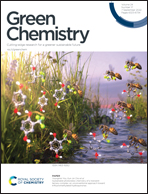Superior bifunctional cobalt/nitrogen-codoped carbon nanosheet arrays on copper foam enable stable energy-saving hydrogen production accompanied with glucose upgrading†
Abstract
Electrocatalytic overall water splitting is a sustainable method to produce renewable hydrogen energy, but its industrial-scale application is limited by the high energy consumption caused by the high overpotential. Herein, we report the first example of constructing bifunctional cobalt/nitrogen-codoped carbon (CoNC) nanosheet arrays on copper foam (CF) to drive an energy-saving H2 production system with glucose-assisted Cu(I)/Cu(II) redox-looping. A series of size-controllable CoNC nanosheet arrays derived from a ZIF-L precursor are assembled on CF to balance the activity and durability of glucose-assisted Cu(I)/Cu(II) redox-looping and the HER. The optimized CoNC arrays can not only act as a highly-active electrocatalyst of the HER with outstanding electrochemical activity (η10 = 64 mV), but also protect the copper sites of CF from leaching in the glucose-assisted Cu(I)/Cu(II) redox-looping, thus significantly improving the stability of this self-supported electrode. Consequently, a superior energy-saving glucose-assisted system can be assembled by using this bifunctional Cu/CoNC as both the cathode and anode, which exhibits an ultra-low input cell voltage of 0.9 V to achieve 100 mA cm−2 with an ultra-low electricity consumption of 1.97 kW h per cubic meter of H2, much lower than the theoretical value of conventional overall water splitting (1.23 V and 2.7 kW h).



 Please wait while we load your content...
Please wait while we load your content...